10 Ways to Create a Colorful Maximalist Living Room
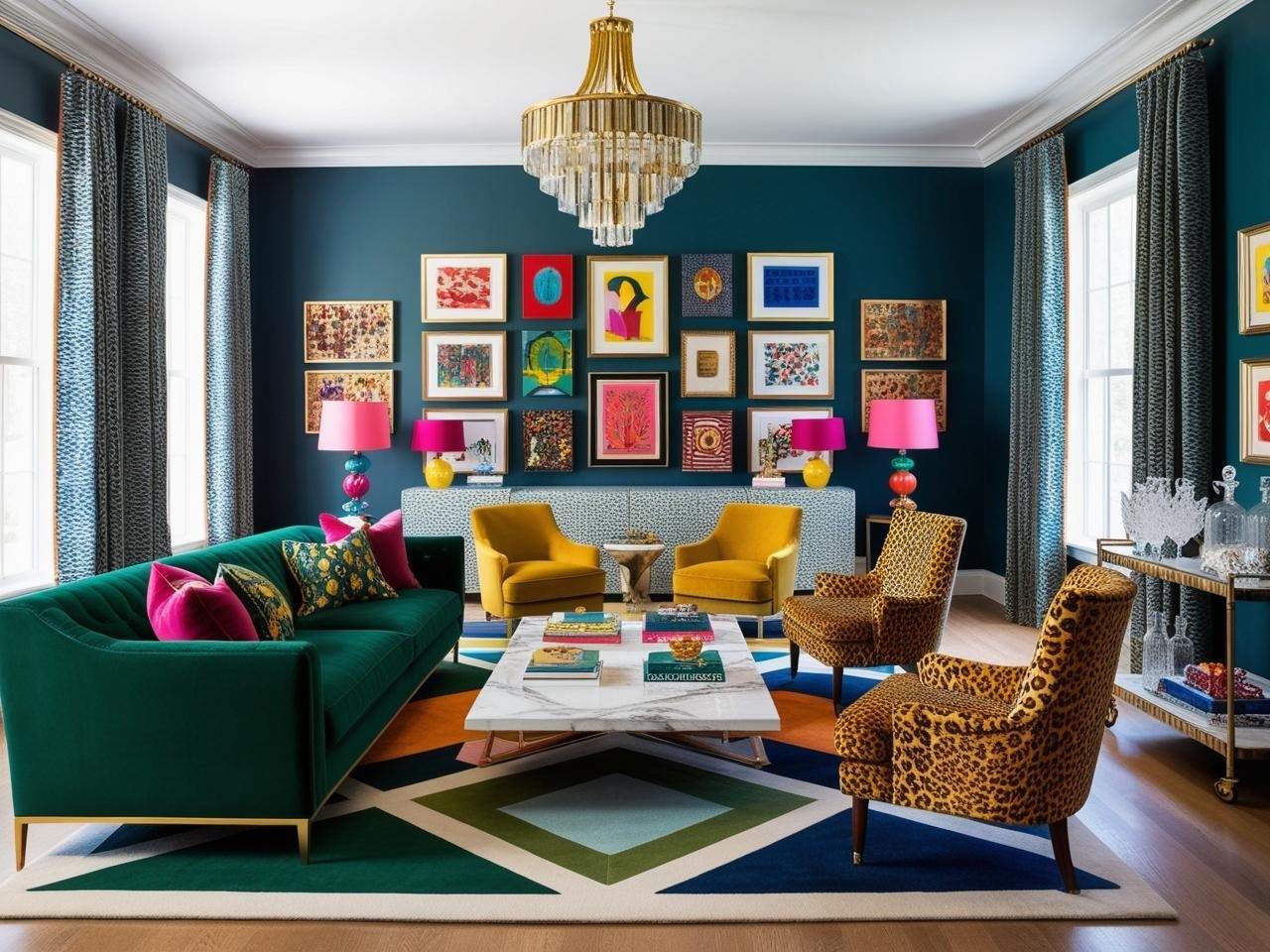
Remember when we all thought beige was bold? (I know, I know – we’ve come a long way!) These days, maximalism isn’t just a design choice; it’s a full-on celebration of everything that makes our spaces uniquely ours. And if you’re standing in your living room right now, looking at your beloved collection of… well, everything, wondering how to make it all work together? You’re in exactly the right place.
Let me tell you about my own maximalist awakening. It happened when I finally gave myself permission to stop apologizing for loving both sleek modern pieces AND my grandmother’s ornate vintage mirror. Turns out, the “rules” about not mixing styles were made to be broken – and breaking them is where the magic happens.
Here’s what I’ve discovered after years of embracing the “more is more” philosophy (and yes, making plenty of entertaining mistakes along the way): creating a maximalist living room isn’t about following a strict formula. It’s about building a space that tells your story, holds your treasures, and makes you smile every time you walk through the door.
Whether you’re trying to figure out how to make your vintage art collection play nice with your modern furniture, or you’re wondering if that bold wallpaper really can work with your patterned sofa (spoiler alert: it totally can), I’m here to share everything I’ve learned about creating spaces that are both beautiful and livable.
So grab your favorite beverage, get comfortable, and let’s dive into the wonderful world of maximalist design. Trust me – by the time we’re done, you’ll be looking at your space with fresh eyes and plenty of new ideas. And the best part? There’s no such thing as getting it wrong – just different degrees of getting it spectacularly you.
Ready to embrace your inner maximalist? Let’s do this!

Choose Bold Color Schemes for Your Maximalist Living Room
You know that moment when you’re staring at your paint swatches, and suddenly all those colors you were so sure about start to swim together? Been there. The thing about maximalist color schemes is that they’re less about following rules and more about finding what makes your favorite pieces sing together.
Starting with What You Love
Here’s a little secret I’ve discovered through countless room designs: start with the colors in your can’t-live-without pieces. Maybe it’s that vintage emerald green armchair you scored at an estate sale, or the peacock blue rug that caught your eye on vacation. These pieces aren’t just furniture – they’re your color story waiting to happen.
Building Your Color Confidence
The magic happens when you start playing with contrast. Think of it like creating a playlist – sometimes the unexpected combinations create the best harmony. A deep navy wall can make that mustard yellow sofa absolutely radiate, while a punch of coral brings everything to life. The key? Don’t feel pressured to use every color you love all at once.
Using Color to Define Spaces
One of my favorite techniques for open-plan spaces is using color to create distinct zones without putting up walls. A rich terracotta in your dining area can flow beautifully into a sage green living space, especially when you use pieces that incorporate both colors to bridge the gap. It’s like creating neighborhoods in your home, each with its own personality but still part of the same community.
The Power of Monochrome Moments
Sometimes the boldest move isn’t using every color – it’s going deep into one color family. Imagine a living room in six different shades of blue, from pale sky to deep midnight. The trick is varying the textures and materials to keep things interesting. Think velvet pillows against linen curtains, or a glossy ceramic lamp on a matte painted wall.
Making It Work Together
Remember, the goal isn’t perfection – it’s creating a space that feels authentically you. If you’re unsure about a color combination, try bringing in some neutral breaks (think warm whites or soft grays) to give your eyes a rest. And don’t be afraid to experiment – some of the most interesting rooms I’ve seen started with what seemed like an “odd” color choice that ended up tying everything together perfectly.
Want to test drive a color scheme? Gather items you already own in your potential palette and arrange them together. It’s like a dress rehearsal for your room, minus the commitment of painting an entire wall. You might be surprised at how colors you never thought would work together suddenly make perfect sense in the right proportions.
Your Shortcut to Effortless Moody Lux Style
12 refined color palettes designed to bring luxury, drama and harmony into your home.
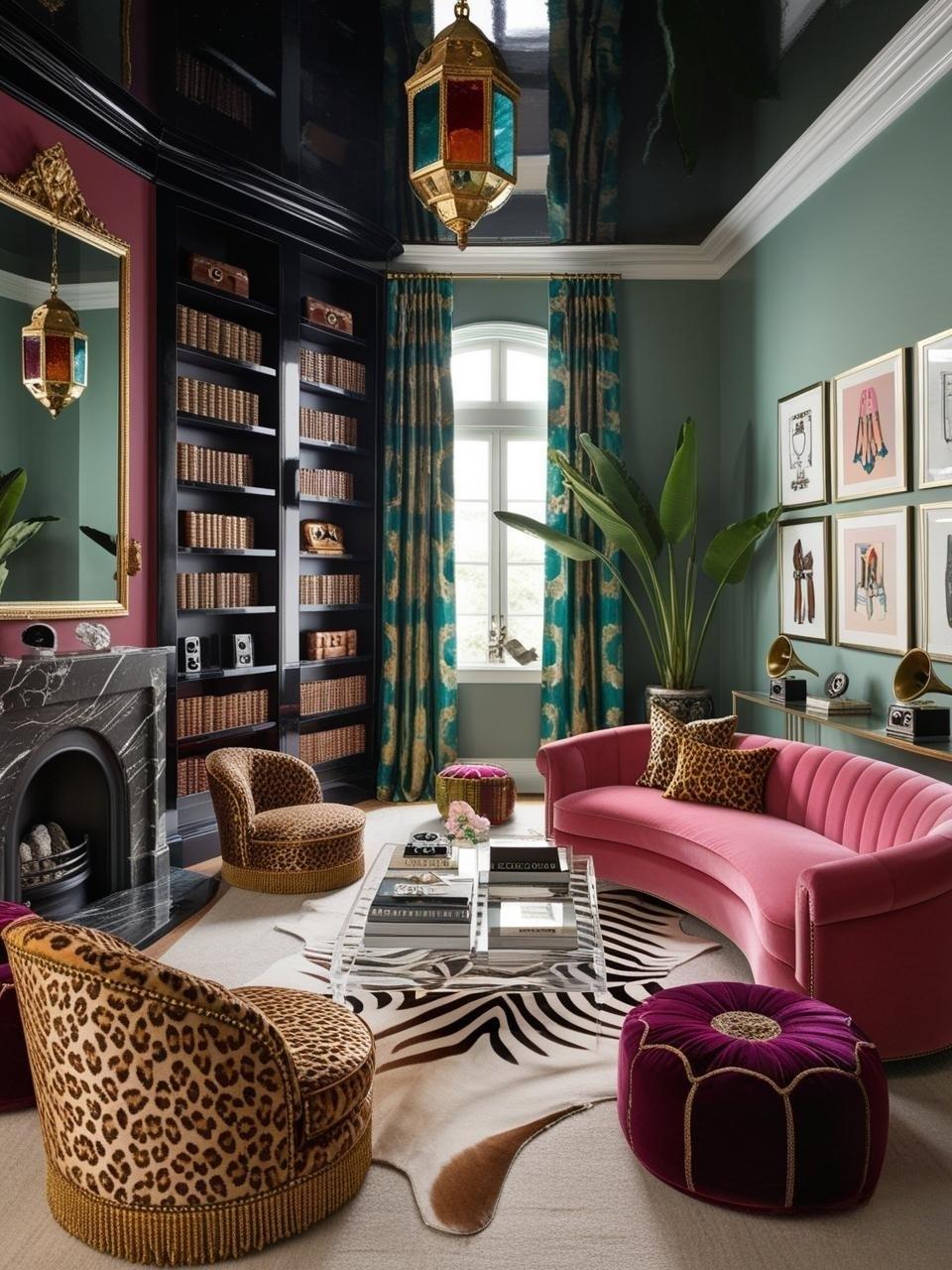
Mismatched Furniture: The Heart of Maximalist Design
Let’s talk about the moment that changed everything for me – when I realized my grandmother’s ornate Victorian side table actually looked amazing next to my sleek, modern sofa. It was like discovering that chocolate and sea salt go together. Who knew? Well, apparently maximalists did, and they’ve been onto something this whole time.
The Magic of the Mix
Here’s what makes mismatched furniture so special: every piece gets to tell its own story while contributing to a bigger conversation. That vintage leather armchair with the perfect patina? It might just be the ideal companion for your contemporary glass coffee table. The trick isn’t finding pieces that match – it’s finding pieces that complement each other in unexpected ways.
Creating Your Furniture Foundation
Start with what I like to call your “anchor piece” – maybe it’s that oversized velvet sofa you couldn’t live without, or the mid-century credenza that spoke to your soul. This piece sets the tone but doesn’t dictate the rules. Think of it as the host of your furniture party – welcoming to all, but with its own distinct personality.
Playing with Scale and Proportion
One of the most fun aspects of mismatched furniture is playing with different sizes and shapes. A low-slung chaise can live harmoniously with a tall wingback chair, especially when you balance them with a medium-height piece between them. It’s like composing a visual symphony – you need different notes to create the melody.
The Art of Spacing
Here’s a little secret I’ve learned: breathing room is everything. When you’re working with different styles, giving each piece a little space to shine makes the whole room feel intentional rather than cluttered. It’s the difference between an orchestra and a bunch of musicians playing at the same time – spacing creates harmony.
Making Different Eras Play Nice
You might worry that your Art Deco bar cart will clash with your contemporary dining table, but here’s the thing: when you mix periods thoughtfully, each piece becomes more interesting. The key is finding common elements – maybe they share a similar wood tone, or their shapes echo each other in subtle ways. Sometimes the most surprising combinations become the most compelling conversations starters in your space.
Finding Your Balance
Remember, there’s no formula for the perfect mix – it’s more about developing an eye for what feels right. Start by grouping furniture in small vignettes and step back. Does something feel off? Maybe that streamlined desk needs a chunky vintage table lamp to balance it out. Trust your instincts – they’re probably better than you think.
The beauty of mismatched furniture is that it creates a space that couldn’t possibly belong to anyone else. It’s the design equivalent of your signature – totally unique and impossible to replicate. And isn’t that what making a home is all about?
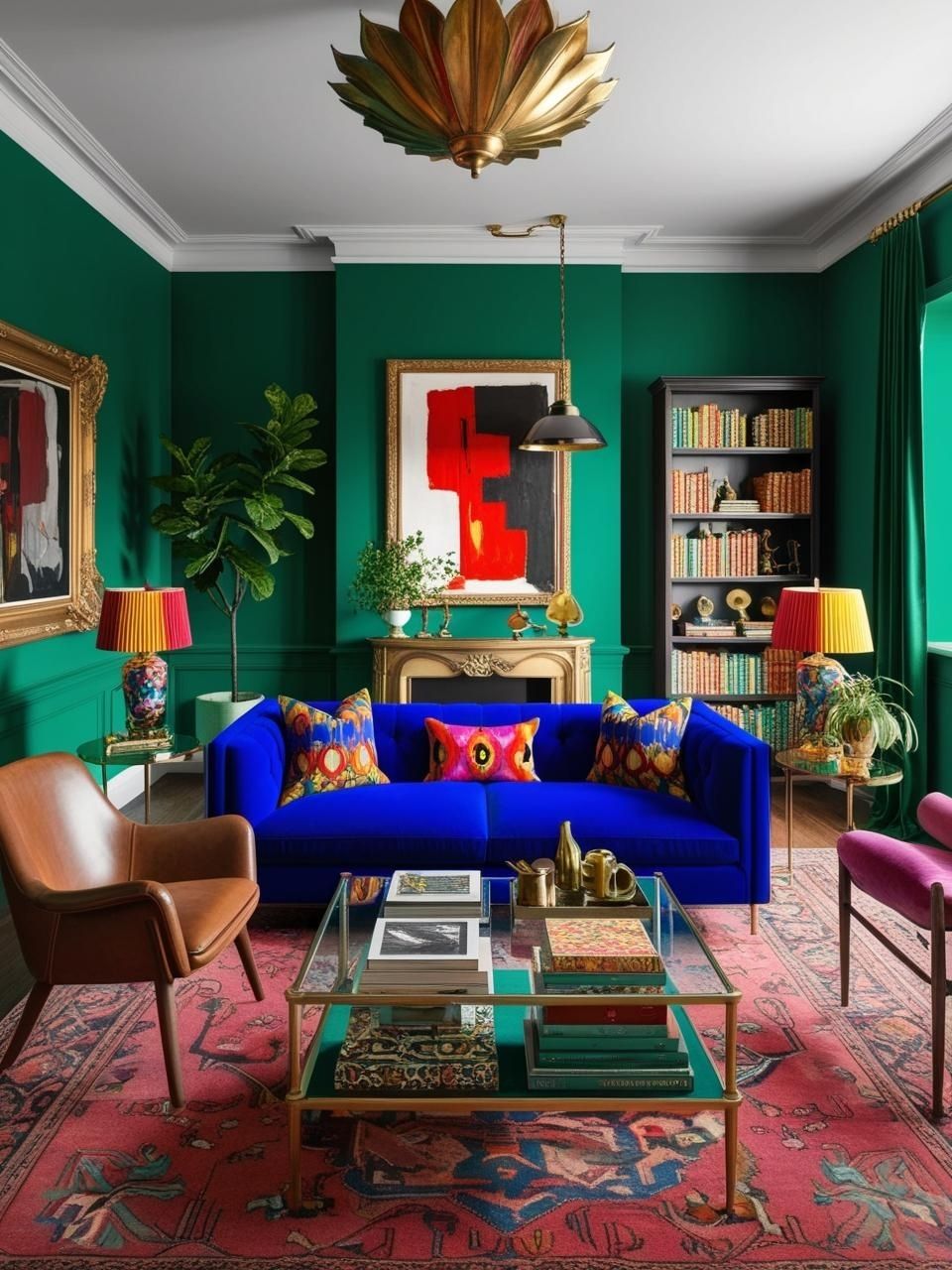
Layering Textiles and Patterns for a Cozy, Bold Look
Remember the first time you tried mixing patterns and it felt like you were wearing plaid with polka dots to a middle school dance? Totally been there. But here’s what I’ve discovered after years of pattern-mixing adventures: there’s actually no such thing as clashing patterns – just patterns that haven’t found their perfect wingman yet.
The Texture Tango
Let’s talk texture, because this is where the magic starts. Picture this: a buttery leather sofa cozied up with rumpled linen pillows and a few velvet throws. It’s like creating a fabric party where everyone’s dressed differently but somehow looks amazing together. The secret? Making sure each texture gets its moment to shine.
I once played it safe with an all-cotton situation in my living room, and let me tell you – it had all the excitement of a beige carpet. Now I know better: mixing textures is like seasoning your favorite dish. A little rough here, a little smooth there, and suddenly everything’s more interesting.
Pattern Play Without the Panic
Here’s a little trick I stumbled upon: start with three patterns – one floral, one geometric, and one stripe. Think of them as the three musketeers of pattern mixing. Your bold floral throw pillow might seem like a lot at first, but pair it with a subtle striped blanket and a geometric rug? That’s when the conversation gets interesting.
Size Matters (In Patterns)
Another game-changer I learned (after a few interesting attempts): vary your pattern sizes. If your rug is rocking large-scale florals, try smaller geometric patterns for your pillows. It’s like a visual playlist – you need different beats to keep it interesting.
The Solid Color Savior
Let me share a little rescue mission story: I once got a bit too excited about patterns and ended up with what looked like a fabric store explosion. The fix? Solid-colored pieces that create visual breaks. Think of them as the palate cleansers of your room – they give your eyes a place to rest while making all those patterns pop even more.
Pulling It All Together
The real secret sauce? Finding your “bridge” pieces – those magical textiles that contain colors from both your patterns and solids. Maybe it’s that throw blanket with threads of both your accent color and your base tone, or that pillow that somehow ties together your three favorite patterns.
Remember when we were all afraid of mixing navy and black? Or convinced that patterns had to “match”? Those were the days! Now we know better: it’s not about matching – it’s about creating a conversation between different pieces. And sometimes the most interesting conversations start with “I wonder if these would work together…”
Want to test the waters? Start small with a pillow party on your sofa. It’s like a dress rehearsal for your room’s pattern-mixing debut, and you can rearrange to your heart’s content until it feels just right.
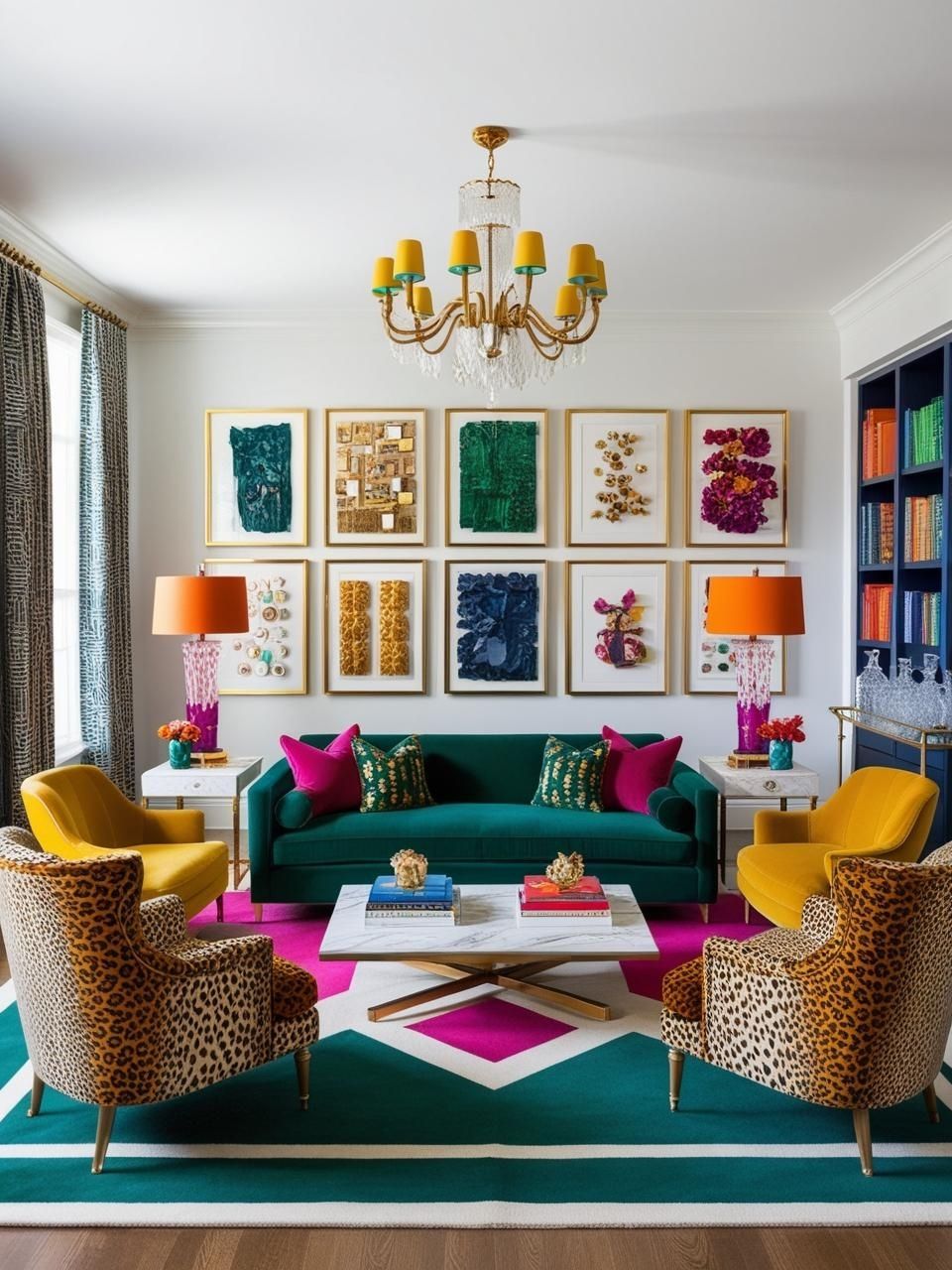
Incorporating Art and Accessories to Personalize the Space
You know that moment when you’re standing in front of a perfectly styled room and something just feels… missing? That’s usually when I realize we haven’t added the personality yet – those wonderful, weird, completely-you pieces that transform a space from “nice room” to “definitely my room.”
The Art of, Well, Art
Here’s a little secret: art doesn’t have to match your sofa. I used to be that person, hunting for the perfect piece in exactly the right shade of blue to match my throw pillows. Now I know better – the best art is the kind that makes you feel something, even if that something is “this totally clashes with everything and I absolutely love it.”
Large-scale pieces can be game-changers, but don’t feel pressured to fill every wall. Sometimes that vintage concert poster you found at a flea market has more impact than a giant canvas. It’s about finding pieces that tell your story, whether that’s a massive abstract painting or a gallery wall of family photos mixed with local artist prints.
Creating Your Personal Museum
Think of your shelves and surfaces as your personal exhibition space. That ceramic bowl you brought back from Portugal? Give it prime real estate next to your design books. The quirky sculpture you inherited from your aunt? Let it be a conversation starter on your coffee table. The key is creating little vignettes that feel curated but not precious.
The Bookshelf Symphony
Let’s talk about bookshelves, because they’re basically the ultimate personality showcase. Gone are the days of color-coding every spine (unless that brings you joy – then color-code away!). Try mixing horizontal and vertical stacks, leaving some breathing room for those random treasures you’ve collected. That tiny brass elephant from your travels might just become the perfect bookend.
Memory Lane Meets Design Lane
Remember that phase when we all tried to hide our personal photos in albums? Yeah, me too. But here’s what I’ve learned: family photos and travel snapshots can be part of your design story. Mix them with your art pieces, pop them in unexpected frames, create clusters that tell a story. Just maybe skip the life-size wedding portrait over the fireplace (learned that one the hard way).
The Evolution of Display
The beauty of accessories is that they can evolve with you. That shelf arrangement you love today? Feel free to switch it up next month. I like to think of it as curating my own little design exhibition, where the shows change but the underlying story – yours – stays the same.
One of my favorite tricks is the “step back and squint” test. If your displays still look interesting when blurred, you’ve probably got the right balance of heights, shapes, and negative space. And if not? No worries – that’s what Sunday afternoon rearranging sessions are for.
Your space should feel collected, not decorated. It’s the difference between a room that could be in any home and one that could only possibly be yours. And isn’t that exactly what we’re going for?
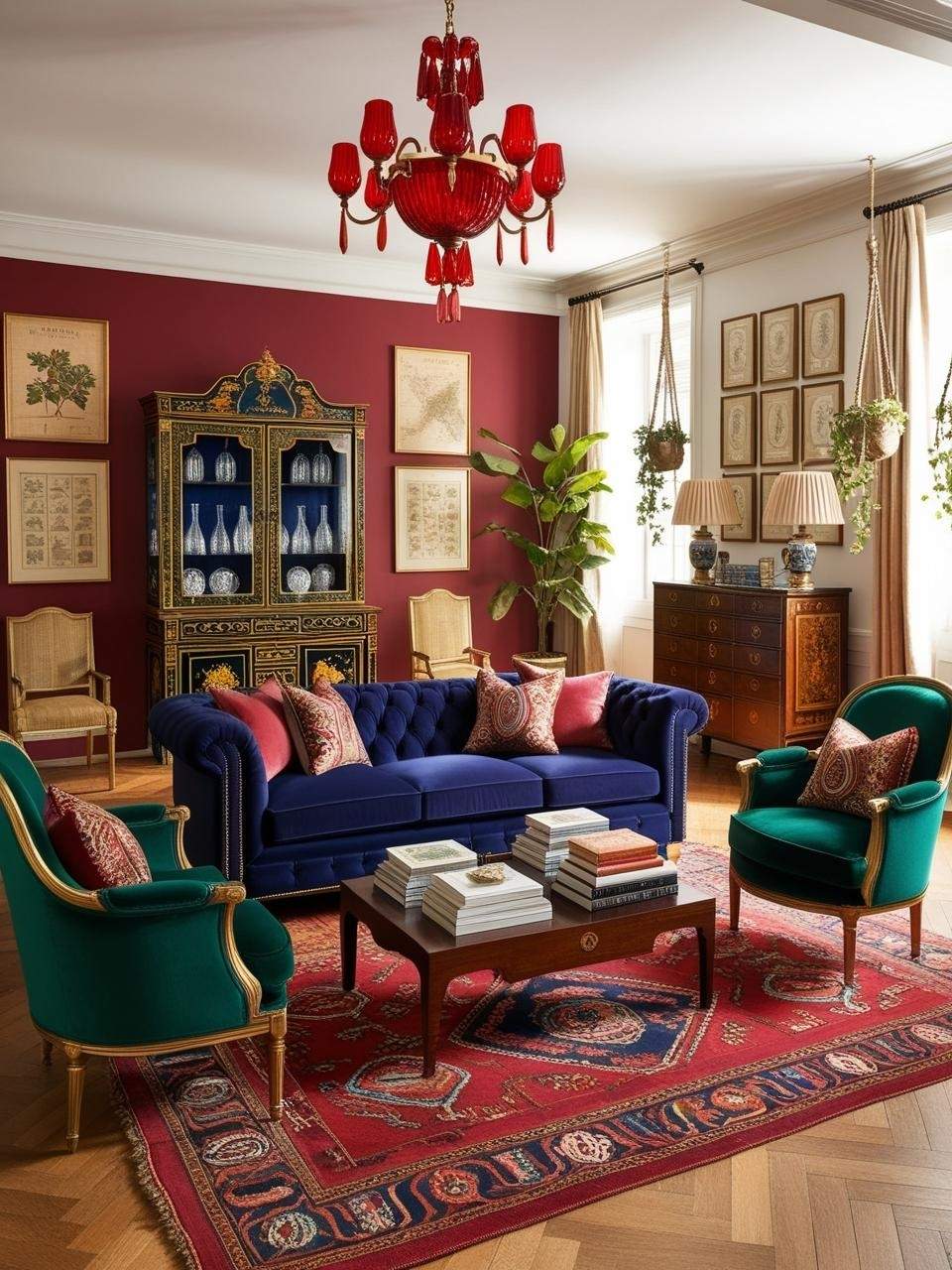
Creating a Focal Point with Statement Lighting
True story: I once thought a single overhead light was all a room needed. (I know, I know – we all have design choices we’d rather forget!) But here’s the thing about lighting: it’s like jewelry for your room. And just like that statement necklace that pulls together your whole outfit, the right lighting can make a space go from “nice” to “wow, how did you do that?”
The Power of Going Bold
Let’s talk about that moment when you find the perfect statement light. You know the one – maybe it’s that oversized rattan pendant that makes your heart skip a beat, or that sculptural floor lamp that looks like modern art. Trust that instinct! I’ve learned that when it comes to lighting, sometimes the piece you think might be “too much” is exactly what the room needs.
Playing with Levels
Here’s a little lighting secret I stumbled upon: think of your room like a theater stage. You wouldn’t light a play with just a spotlight, right? Your space needs its main act (hello, gorgeous chandelier), supporting characters (those perfect table lamps), and the behind-the-scenes crew (strategically placed floor lamps and sconces).
The Mood Master
Remember when I discovered that changing a bulb’s warmth could make my vintage brass lamp look either like a fancy antique or something from a cold office building? Game changer! Playing with different light temperatures isn’t just about brightness – it’s about creating moments in your space. Warm light for cozy corners, brighter light for where you need to see what you’re doing (because no one wants to read a book in moody lighting, trust me).
Unexpected Light Love
Can we talk about how string lights aren’t just for dorm rooms anymore? I had this client who was skeptical about adding cafe lights to her sophisticated dining room – until she saw how they created this magical ambient glow during dinner parties. And don’t even get me started on the joy of a well-placed neon sign. Sometimes the most unexpected lighting choices become your favorite part of the room.
Making It All Work Together
The real magic happens when you start mixing different types of lighting. That vintage table lamp might look even better when it’s paired with a modern floor lamp. And that dramatic chandelier? It gets to be even more of a star when it has some subtle recessed lighting playing backup.
One of my favorite tricks is to walk through your space at different times of day. That gorgeous pendant light might look perfect at noon, but how does it serve you during your evening Netflix sessions? It’s all about creating options for different moments and moods.
Remember: there’s no rule that says all your lighting has to match. Just like how we’ve learned to mix our metals and blend our styles, lighting is another opportunity to show off your design personality. And if you’re not sure? Start with one statement piece and let it guide you. Sometimes the best lighting plan starts with falling in love with a single fixture and building from there.

Playing with Shapes: Organic and Geometric Styles in Maximalism
Let me tell you about my shape-mixing epiphany. There I was, convinced that my living room needed to commit to one lane – either curvy and organic or clean and geometric. Plot twist: the space only really came alive when I stopped trying to choose sides. It’s like that moment when you realize chocolate-covered pretzels are amazing because they’re both sweet and salty.
The Dance of Curves and Lines
You know what’s funny about shapes? We often overthink them. I once spent weeks agonizing over whether a round coffee table would “work” with my square sofa, only to discover that the contrast was exactly what the room needed. It’s like the design equivalent of mixing polka dots with stripes – sometimes the unexpected pairing creates the most interesting conversation.
Finding Your Shape Story
Here’s a little secret I’ve picked up along the way: every room needs both its sharp moments and its soft spots. Think of it like composing a photograph – those angular bookshelves might look even better when they’re housing your collection of rounded ceramic vases. And that super-geometric rug? It might be the perfect foundation for your sinuous, curved sofa.
Mirror, Mirror on the Wall
Can we talk about mirrors for a second? I used to be firmly in the “rectangular mirrors only” camp until I discovered how a circular mirror could completely transform a room full of straight lines. It’s like adding a full moon to a cityscape – suddenly everything feels more balanced, more intentional. Plus, let’s be honest, who doesn’t love the way a round mirror softens up a gallery wall?
The Joy of Juxtaposition
Here’s something I’ve learned through countless room designs: contrast creates energy. That sleek, angular side table? It absolutely sings next to a plump, rounded armchair. It’s not about following rules – it’s about creating little moments of visual surprise that make your space feel alive.
Making It All Flow
The trick to mixing shapes (and this took me an embarrassingly long time to figure out) is to create echoes throughout the room. Maybe the arch of your floor lamp subtly references the curve of your dining chairs, or the geometric pattern in your pillows picks up the angles of your coffee table. These little connections are what make a room feel thoughtfully curated rather than randomly assembled.
Remember that time when everything in our homes had to be mid-century modern angular? Or when we all went curved everything? Yeah, those days are behind us. Now we know better: the magic happens in the mix. And the best part? There’s no such thing as getting it wrong – it’s all about what feels right to you.
Truth bomb: sometimes the most interesting rooms are the ones that break all the “rules” about shapes. Because at the end of the day, if that super-geometric artwork makes you smile every time you look at it, who cares if it’s hanging above your curviest, most organic sofa? That’s not a design mistake – that’s your signature style coming through.
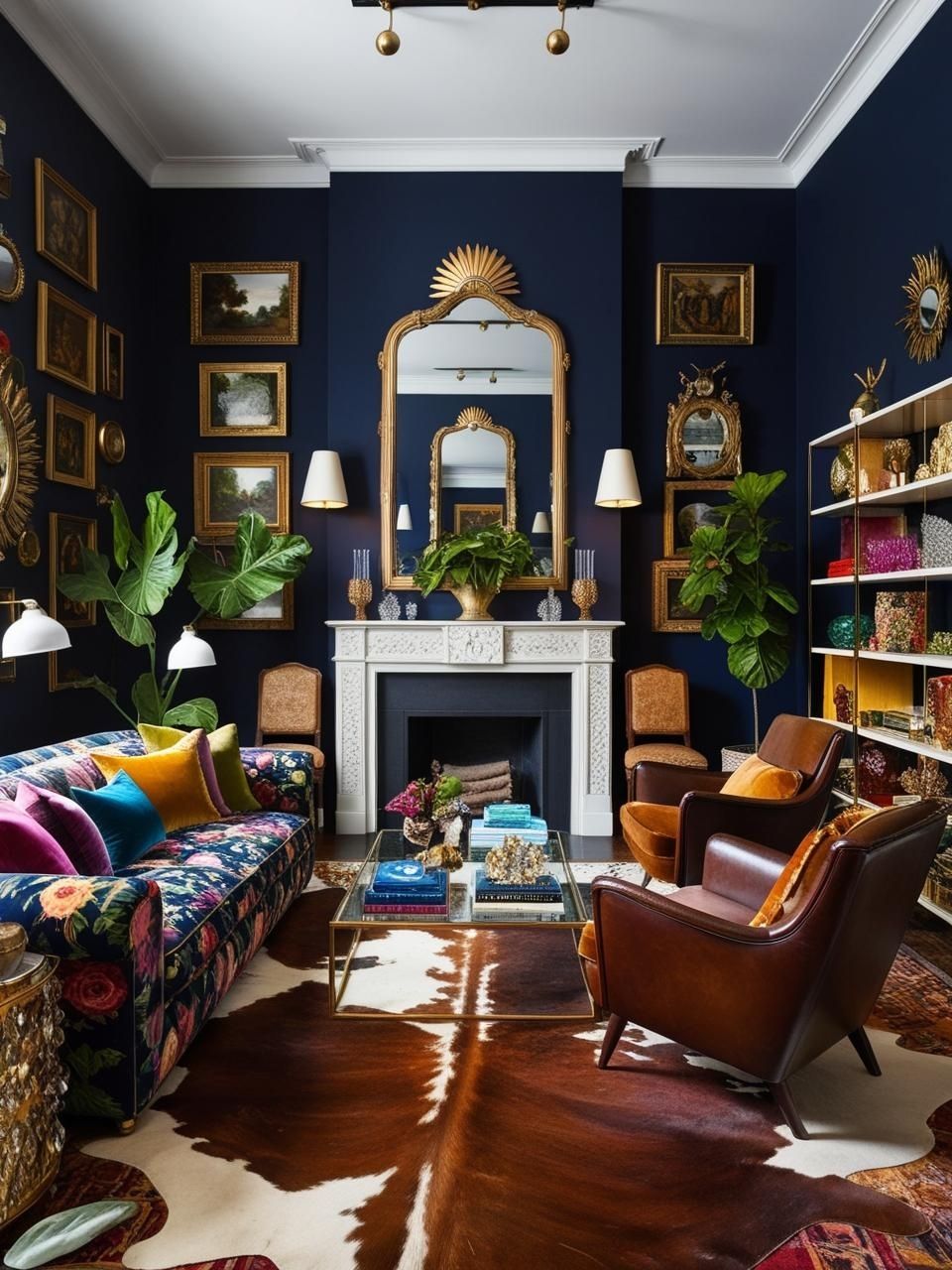
Bringing Nature Indoors: Incorporating Plants in Maximalist Rooms
Remember when I thought I could keep a fiddle leaf fig alive by sheer force of will? (Spoiler alert: I couldn’t.) But here’s the thing about adding plants to a maximalist space – even those of us who’ve accidentally turned a few green friends crispy have discovered that plants are like the cool kids at the party. They somehow make everything and everyone look better.
Going Big and Bold
Let’s talk about my love affair with statement plants. You know that moment when you bring home a massive monstera and suddenly your room feels like it took a deep breath? There’s something magical about large-leaf plants in a maximalist space. They’re like nature’s answer to bold artwork, except these masterpieces actually grow bigger over time (when we manage to keep them alive, that is).
The Great Plant Mix-Up
Fun story: I used to think all my plants needed to be the same shade of green. I know, I know – what was I thinking? Now I know better. Mixing plants is like creating a little jungle orchestra: you’ve got your tall, structural snake plants playing backup to the flowing melody of a trailing pothos, while a peace lily adds its own special solo. It’s not about matching; it’s about creating your own green rhythm.
The Vertical Adventure
Can we talk about plant hangers for a second? Because discovering that plants could live above eye level was a total game-changer. I once transformed a boring corner into everyone’s favorite spot just by hanging plants at different heights. It’s like creating a living chandelier, minus the crystal maintenance (though occasionally you do have to rescue a wandering vine from your houseguests’ hair).
Plant Personalities
Here’s something I’ve learned: plants have personalities just like furniture does. That sassy calathea that demands filtered water and daily misting? She’s the diva your maximalist room didn’t know it needed. And that hardy ZZ plant that thrives on neglect? Think of it as your room’s reliable best friend.
The Softening Effect
You know how sometimes a room full of bold patterns and sharp angles can feel a bit… intense? That’s where our green friends come in clutch. Plants are like natural mediators – they soften those hard edges and make even the boldest wallpaper feel more approachable. Plus, they’re experts at filling those awkward spaces where nothing else seems to fit quite right.
Creating Your Green Story
The secret to mixing plants in a maximalist space? Think of them as part of your color story, not just green accessories. That purple oxalis? It’s having a conversation with your plum velvet sofa. The silvery leaves of your string of pearls? They’re picking up the metallic threads in your throw pillows.
Remember when we all thought one giant plant in the corner was enough? Those were simpler times! Now we know that plants, like patterns and colors, love company. And the best part? If something’s not working, you can always do a little plant shuffle. Trust me, they don’t mind being part of your design experiments – as long as you remember to water them, of course!

Maximalist Decor on a Budget: Thrift Finds and DIY Ideas
Let me tell you about the vintage brass lamp that changed everything. There I was, walking through my local thrift store, when I spotted it: absolutely perfect, absolutely hideous finish, absolutely $15. That lamp taught me my first real lesson about budget decorating: sometimes the best pieces are just wearing the wrong outfit.
The Art of the Hunt
Here’s what I’ve learned about thrifting after countless treasure hunts: the best finds usually happen when you’re not looking for anything specific. It’s like dating – the moment you stop desperately searching for “the one,” you find a perfect match. That’s how I ended up with a pair of mid-century side tables that just needed a little love (and okay, maybe a complete refinishing job).
Getting Your Hands Dirty
Can we talk about DIY fails for a second? Because that time I tried to chalk paint an entire dining set in my tiny apartment living room… well, let’s just say my security deposit had some thoughts about that. But here’s the thing: some of my favorite pieces started as complete disasters. That vintage credenza with the awful orange finish? A weekend of sanding and some new hardware later, and suddenly it’s the star of my dining room.
The High-Low Dance
Remember when everything in our space had to be “investment pieces”? Thank goodness we’re over that! Some of my favorite rooms mix a splurge-worthy sofa with a thrifted coffee table that cost less than tonight’s takeout. The secret? It’s all in how you style them together. That $5 brass candlestick looks a lot more expensive when it’s hanging out with your nice table lamp.
Creative Solutions, Big Impact
Want to know my favorite budget-friendly game-changer? Paint. Yes, really! Whether it’s creating your own abstract art canvas (hello, Saturday afternoon project), giving new life to old frames, or even tackling an accent wall, paint is like fairy dust for your space. And the best part? If you hate it, you can always paint over it. Ask me how I know.
The Refresh Without the Regret
Here’s a little trick I’ve picked up: start a decor rotation system. Those pillows you’re tired of in the living room? They might be exactly what your bedroom needs. That art piece that’s not working over the sofa? Try it in a gallery wall with some thrifted frames. Sometimes the best “new” decor is just your old decor in a different spot.
Making Magic with What You Have
The real secret to maximalist decorating on a budget? Learning to see the potential in everything. That pile of vintage books at the thrift store? Instant sculptural moment when stacked on your coffee table. Those mismatched plates? Gallery wall waiting to happen. That old scarf you never wear? Hello, new pillow cover!
You know what’s funny? Some of my most-complimented pieces are the ones that cost the least. Like that “vintage” brass mirror that I found at a yard sale for $10 – the one everyone assumes is some fancy designer find. The best part about budget decorating isn’t just saving money; it’s the stories each piece brings to your space. Because really, isn’t “Oh, you’ll never believe where I found this” so much more interesting than “I ordered it online”?
Unlock Designer-Perfect Colors in Minutes
Browse my curated collection of interior color palettes—tailored for today’s most loved design styles.

Embracing Cultural Influences in Your Maximalist Living Room
You know that moment when you realize your obsession with Moroccan poufs, Scandinavian textiles, AND Japanese ceramics might actually work together? That was my design awakening. Because here’s the thing: great design is like great food – sometimes the most unexpected combinations create the most memorable experiences.
The Global Mix Master
Let me share a little story about my first attempt at cultural mixing. Picture this: I had just returned from a trip to Marrakech, completely smitten with the patterns and colors. In my excitement, I may have gone a tiny bit overboard. (Spoiler alert: there is such a thing as too many kilim pillows in one room.) But that enthusiasm led to something interesting – discovering how those bold Moroccan patterns could actually sing alongside my beloved Swedish minimalist pieces.
Finding Your Story
Here’s what I’ve learned about mixing cultural influences: it’s less about following strict design rules and more about creating connections. That hand-painted Turkish plate? It might share the same blue tones as your grandmother’s Danish porcelain. Suddenly, pieces from opposite sides of the world are having a delightful conversation on your wall.
The Art of Authentic Mixing
Let’s talk about the elephant in the room – how do we mix cultural pieces respectfully? I’ve found that the key is in understanding and appreciating the stories behind our pieces. Those aren’t just “exotic” accessories; they’re pieces of craftsmanship with rich histories. When we honor that, our spaces become more than just pretty rooms – they become storytellers.
Creating Balance with Contrast
You might think that Scandinavian minimalism and Indian maximalism would clash – but plot twist! They often create the most interesting spaces together. Think of it like this: that clean-lined Danish credenza becomes even more striking when it’s displaying your collection of colorful Indian brass vessels. It’s all about giving each piece room to breathe while letting them complement each other.
Texture Tales
One of my favorite discoveries was realizing that texture is a universal language in design. A handwoven Mexican blanket can have a fascinating dialogue with a roughly glazed Japanese vase. They might come from different corners of the world, but they share a handcrafted soul that makes them natural companions.
Remember when we used to think rooms had to commit to one cultural style? Those were simpler times! Now we know that our spaces can be as well-traveled as we are. The trick isn’t about following rules – it’s about creating a space that tells your story, honors the cultures that inspire you, and makes you smile every time you walk in the door.
And hey, if someone asks you how you made that Bohemian wall hanging work with your collection of Scandinavian ceramics? Just tell them it’s like hosting a great dinner party – sometimes the most interesting conversations happen when you mix up the seating chart a little.
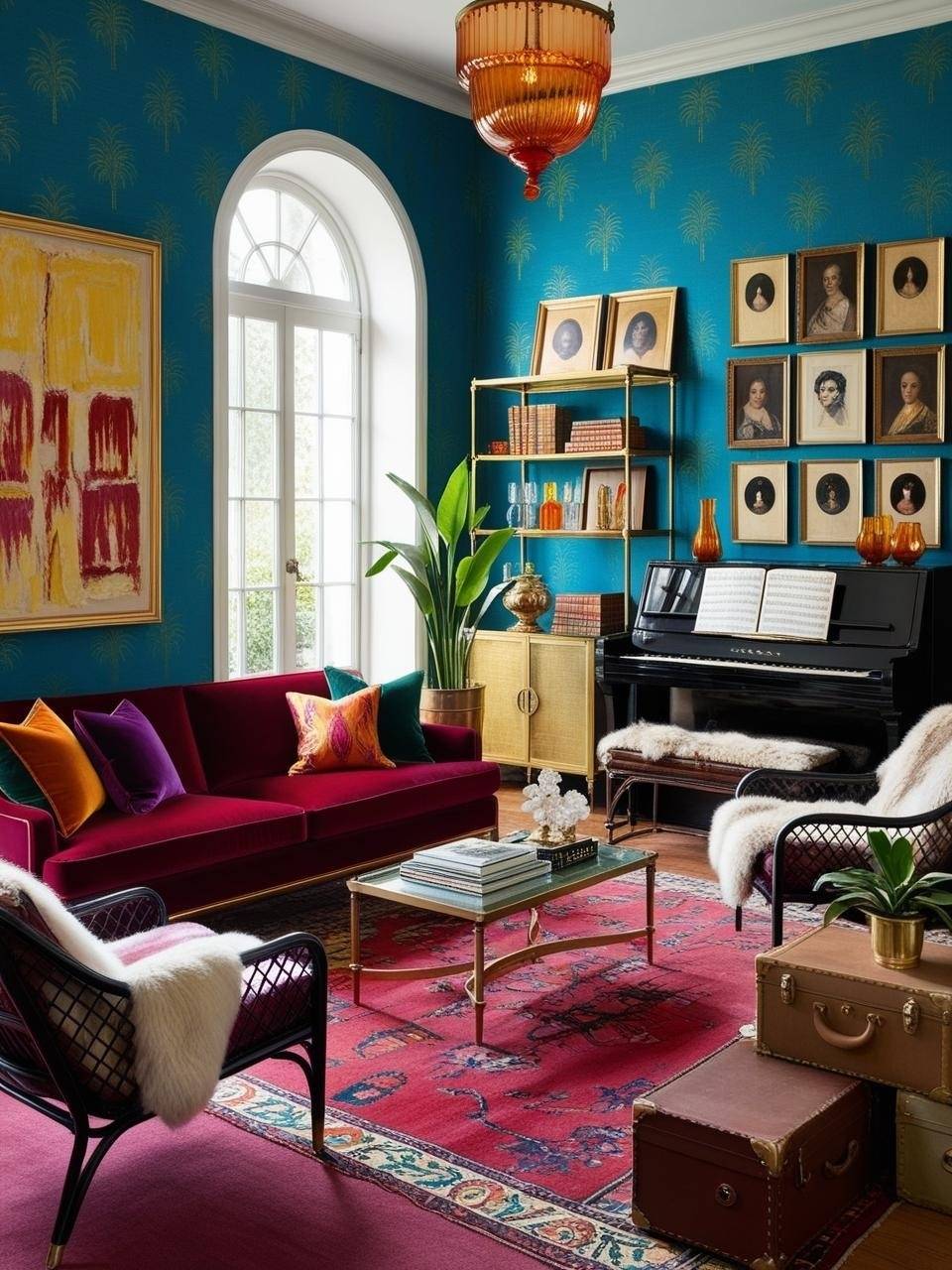
Maximizing Functionality While Maintaining Visual Interest
Let’s talk about the elephant in the maximalist room: how to actually live in these spaces we’ve created. Because I’ll admit it – I once designed a living room that looked amazing in photos but had nowhere to put down a coffee cup. Lesson learned! The best maximalist spaces aren’t just pretty; they’re pretty useful too.
The Reality Check
Here’s a confession: I used to think “functional” meant “boring.” Then I discovered that clever storage could be just as stunning as any art piece. That vintage trunk I use as a coffee table? It holds all my extra throw blankets. That gorgeous cabinet with the brass hardware? It’s hiding board games and a truly impressive collection of charging cables. Who says practical can’t be beautiful?
Creating Flow That Makes Sense
You know what changed everything for me? Starting to think about my living room like a really good party layout. You need a place for intimate conversations (hello, cozy reading nook), space for group hangs (that’s where your clever seating arrangement comes in), and clear paths to move between them (because nobody likes doing the awkward furniture shuffle with a full glass of wine).
The Storage Solution Revolution
Let me tell you about my favorite design plot twist: visible storage as part of the aesthetic. Those beautiful baskets aren’t just holding magazines – they’re adding texture to your space. That collection of decorative boxes on your shelves? Working double-duty as both display and organization. It’s like the design equivalent of finding out your most stylish friend is also incredibly organized.
Zones That Flow
Here’s something I’ve learned: even the most maximalist space needs breathing room. Think of it like creating little neighborhoods in your room. Maybe there’s your “work from home when you need a change of scenery” corner, complete with that amazing task lamp you thrifted. Then there’s your “Netflix marathon” zone with the world’s most comfortable reading chair. The trick is making these areas feel connected but distinct.
The Comfort Factor
Remember when we all had that one chair that was gorgeous but felt like sitting on a medieval torture device? Yeah, those days are over. I’ve discovered that comfort and style aren’t mutually exclusive – it just takes a bit more hunting to find pieces that deliver both. And sometimes, it’s as simple as adding an extra throw pillow or two (okay, maybe five – but who’s counting?).
Making It All Work
The secret to a livable maximalist space? Everything needs a purpose – even if that purpose is purely to make you smile. That collection of vintage cameras? They’re not just gathering dust; they’re creating an interesting focal point on your bookshelf. Those stacks of design books? They’re doubling as the perfect height-adjuster for your table lamp.
Want to know my favorite test for a well-designed maximalist space? Invite friends over. If they naturally know where to sit, can easily find a place to put their drinks, and linger longer than planned because they’re so comfortable – congratulations! You’ve created a space that’s both stunning and actually livable. And isn’t that the whole point?
Curated Wall Art for Elegant Homes
Bring softness, texture, and intention into your home with digital wall art inspired by wabi-sabi, abstract forms, and muted watercolors. Every piece is crafted to create stillness and beauty—whether you’re styling a gallery wall or a minimalist nook.
Creating Your Maximalist Magic: The Journey Continues
You know what I love most about maximalism? It’s like hosting the best kind of party – one where every guest (or in this case, every design element) brings something special to the mix. And just like any great gathering, it’s not about following rigid rules; it’s about creating moments and memories that feel uniquely yours.
Looking back at our colorful journey through maximalist design, I can’t help but smile at how far we’ve all come from the days when we thought everything had to match perfectly. Remember when we were afraid to mix patterns, or thought bold colors were too risky? Those fears feel like distant memories now, don’t they?
Here’s what I’ve learned, and what I hope you’ll take away: maximalism isn’t about having more stuff – it’s about having more of what matters to you. It’s about creating spaces that tell your story, whether that’s through a carefully curated art collection, an eclectic mix of travel finds, or that absolutely perfect vintage lamp you rescued from obscurity at the thrift store.
The beauty of maximalist design is that it’s always evolving, just like we are. Maybe today you’re all about bold colors and pattern mixing, and tomorrow you’ll fall in love with monochromatic layering. That’s not inconsistency – that’s your style growing and changing with you. And isn’t that exactly what a home should do?
So go ahead – mix those patterns, blend those styles, and create spaces that make your heart sing. Break a few design “rules” along the way (trust me, some of them are begging to be broken). And remember, the only real mistake in maximalist design is trying to make your space look like someone else’s.
Because at the end of the day, the best maximalist rooms aren’t the ones that follow every principle we’ve discussed – they’re the ones that make you smile every time you walk through the door. And if you ask me, that’s what great design is really all about.
Now, who’s ready to start their maximalist adventure?